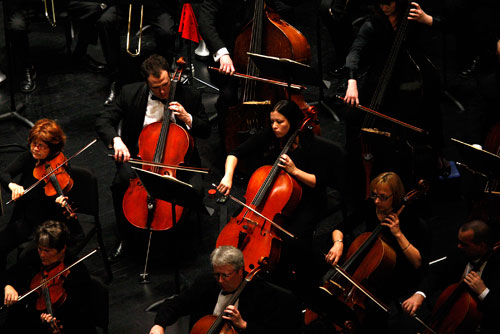CONCERT REVIEW: Las Vegas Philharmonic christens its new home

The elephant in the room was the room. The Las Vegas Philharmonic had its inaugural performance in its new home Saturday night, and the "wow" factor of that home was most certainly part of the experience. The stunning surroundings of The Smith Center could easily have overwhelmed the orchestra by inspiring grandiose expectations, but the Philharmonic was up to the challenge.
Conductor and Music Director David Itkin’s bold choice of Gustav Mahler’s hefty five-movement Symphony No. 2 ("The Resurrection") was a perfect statement. "Goodbye, Artemus Ham Hall. We loved you. Hello, Smith Center. We’re ready for you," he seemed to be saying. "We’re only playing one piece tonight. But it’s a doozy. Now let’s get this new thing going!"
Ready they were, with all the reinforcements required to pull off a successful performance of Mahler’s work: soprano Marie Plette (whose career has only shot higher since winning the Metropolitan Opera National Council Auditions 20 years ago) and mezzo-soprano Eugenie Grunewald (receiving nothing but well-deserved raves for the better part of a decade). Both were in fine form, swaying gently while seated from the Third Movement on, and letting it rip when it was time to stand up and go.
Oh, and there really were 250 singers behind the orchestra silently looking back at the audience — almost eerily — for the better part of an hour until it was their turn to knock your concert socks off. The combined voices of the Las Vegas Master Singers (led by Jocelyn Jensen), UNLV’s Concert Singers and Chamber Chorale (under the direction of David B. Weiller), and the venerable Doug Petersen’s Southern Nevada Musical Arts Society provided the kind of rumble you don’t mind running through your core. Awe-inspiring group hushes were a nice contrast. I expected even more of a firm audio blast.
As the maestro himself rightly notes in informative YouTube videos, the piece is a musical universe unto itself (search YouTube for "David Itkin Mahler"). Besides the enormity of onstage performers (80 orchestra players and the aforementioned 250-person chorus), Mahler specifically includes an eight-person horn section playing only from backstage, providing a true far-off sound and adding a stirring build to the finale.
Rod Serling’s "Twilight Zone" was about half a century away when Mahler composed this buckle-up ride from undulating sadness to triumphant rebirth, and Itkin made a great tuxedoed tour guide through the ethereal, enticing all the heart-rending the players had to offer with coaxing flourishes along the way. If you didn’t work up an emotional sweat, you might well have been in a coma.
The acoustically perfect room delivered rolling fields of subtlety with crisp layers of percussion (two, count ’em, two gongs), brass, woodwind and strings in brilliant sudden displays of dynamics.
Despite a minor misstep here (a sorry trumpet splat in the First Movement’s early going), or an overwrought moment there (hints of disjointedness threatened to derail an otherwise playful circuslike yet foreboding mood in the Third Movement), concertmaster DeAnn Letourneau and the precision musicians of the Philharmonic deserve a tip of the imaginary top hat for bringing their "A" game.
Bon voyage, Las Vegas Philharmonic. Your cruise to new heights has been well-christened. Sure, there may be rough sailing ahead in those unknown waters of the future, but here’s a virtual ink-stained toast to an excellent maiden voyage.